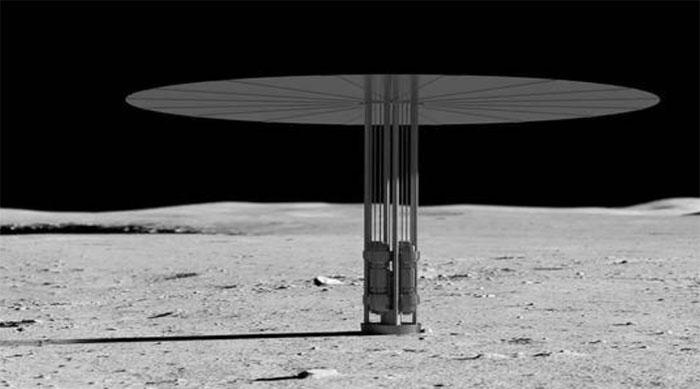The National Aeronautics and Space Administration (NASA) has announced plans to develop nuclear power reactors for future lunar and space exploration missions.
According to RT (Russia), NASA has revealed that it has awarded three contracts for the development of design concepts in collaboration with the Department of Energy (DOE). The massive defense contractor Lockheed Martin and the leading American nuclear company Westinghouse will also participate in this project.

Illustration of the surface nuclear thermal power system from the Artemis program. (Image: NASA)
NASA hopes that the design of the surface nuclear thermal power system will be ready for launch by the end of this decade. John Wagner, Director of the Idaho National Laboratory at the DOE, referred to this project as a “achievable starting point for the U.S. to establish nuclear power on the Moon.”
According to NASA, the three contracts, each worth $5 million and lasting 12 months, will fund initial design ideas for a 40-kilowatt nuclear thermal power system. NASA requires that this system be capable of operating for at least 10 years in the harsh environment of the Moon. The agency also noted that if successfully constructed on the lunar surface, these reactors could be utilized for eventual missions to Mars.
In addition to Lockheed Martin and Westinghouse, a third contractor involved in this project is IX – a joint venture between spacecraft designer Intuitive Machines and Texas-based X-Energy.
Jim Reuter, a representative of NASA’s Space Technology Mission Directorate, commented: “Developing these initial designs will help lay the groundwork for a long-term human presence on other worlds.”
The U.S. space agency believes that smaller, lighter nuclear thermal systems could provide “continuous energy regardless of location, with available sunlight and other natural environmental conditions.” NASA also hopes to gain important insights from the nuclear industry to develop atomic propulsion systems for deep space exploration missions.
Previously, NASA disclosed that nuclear reactors would be built on Earth and then transported to the Moon to provide sustainable energy for future space exploration. The plan for the surface nuclear thermal power system includes a reactor core using uranium fuel, a system to convert nuclear energy into usable electricity, and a thermal management system for cooling.
These contracts are part of the Artemis program, the U.S. space initiative aimed at returning to the Moon and landing the first woman and the first person of color on its surface. The initial timeline for this program was set for 2024, but last year, NASA indicated that it was no longer on track to meet this goal due to funding issues.
In March, NASA announced plans to send humans to Mars by 2040. Less than a week later, the agency canceled the Artemis I spacecraft test due to technical difficulties.
For many years, NASA has placed significant emphasis on nuclear thermal propulsion. They view this technology as the most practical option for future space travel, offering high reliability and efficient energy generation.
“NASA and the DOE are collaborating on this important and challenging development process. Once completed, this will be a remarkable step forward for humanity’s exploration of the Moon and Mars in the long term,” said Todd Tofil, project manager for Fission Surface Power.


















































